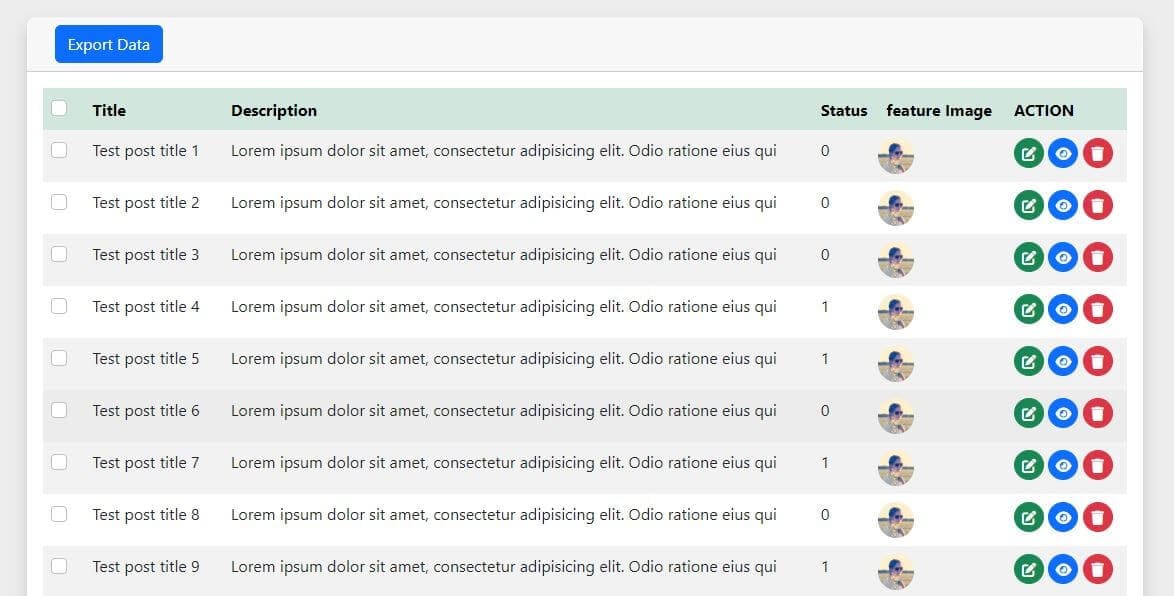How to Export Data to CSV or Excel Format in Laravel 9

- Step 1: Install Laravel Application
- Step 2: Configure Database in the .env file
- Step 3: Create Model, controller, and seeder file using a single command
- Step 4: Migrate the database and seed dummy data
- Step 5: Install the Excel package maatwebsite/excel
- Step 6: Create Routes
- Step 7: Create an export class
- Step 8: Create a Controller
- Step 9: Create a View
- Step 10: Run Laravel Application
Note: If you have already set up your laravel projects you can skip Step 1, Step 2, Step 3, and Step 4. else you can start from Step 1.
Step 1: Install Laravel Application
If you're not familiar with the process, you can refer to the "Install Laravel 9 from Scratch" tutorial. Alternatively, you can run the following command to proceed with this step:
composer create-project laravel/laravel laravel_export_app
Step 2: Configure Database in the .env file
After installing your Laravel application, it is necessary to create a database and configure the .env file appropriately. Below is an example that demonstrates how to configure your .env file:
DB_CONNECTION=mysql
DB_HOST=127.0.0.1
DB_PORT=3306
DB_DATABASE=laravel_export_app
DB_USERNAME=root
DB_PASSWORD=
Step 8: Create a Controller
Now open the App/Http/Controllers/PostController.php file and paste the below code.
<?php
namespace App\Http\Controllers;
use Illuminate\Http\Request;
use Maatwebsite\Excel\Facades\Excel;
use App\Models\Post;
use App\Exports\PostExport;
class PostController extends Controller
{
public function index()
{
$post = Post::get();
return view('posts.index', compact('post'));
}
public function post_export(){
return Excel::download(new PostExport, 'posts.xlsx');
}
}
Step 9: Create a View
Now create an index.blade.php file inside the resources/views/posts folder.
<!DOCTYPE html>
<html lang="en">
<head>
<meta charset="UTF-8">
<meta http-equiv="X-UA-Compatible" content="IE=edge">
<meta name="viewport" content="width=device-width, initial-scale=1.0">
<meta name="csrf-token" content="{{ csrf_token() }}" />
<title>Try it your self</title>
<link href="https://cdn.jsdelivr.net/npm/[email protected]/dist/css/bootstrap.min.css" rel="stylesheet"
integrity="sha384-rbsA2VBKQhggwzxH7pPCaAqO46MgnOM80zW1RWuH61DGLwZJEdK2Kadq2F9CUG65" crossorigin="anonymous">
<link rel="stylesheet" href="https://cdnjs.cloudflare.com/ajax/libs/font-awesome/6.4.0/css/all.min.css"
integrity="sha512-iecdLmaskl7CVkqkXNQ/ZH/XLlvWZOJyj7Yy7tcenmpD1ypASozpmT/E0iPtmFIB46ZmdtAc9eNBvH0H/ZpiBw=="
crossorigin="anonymous" referrerpolicy="no-referrer" />
<script src="https://code.jquery.com/jquery-3.6.4.min.js"
integrity="sha256-oP6HI9z1XaZNBrJURtCoUT5SUnxFr8s3BzRl+cbzUq8=" crossorigin="anonymous"></script>
<style>
body {
background: #ededed;
}
.table_outer {
padding: 20px 0;
}
table td,
table th {
text-overflow: ellipsis;
white-space: nowrap;
overflow: hidden;
}
.card {
border-radius: .5rem;
}
.custom_table tbody .persons {
padding: 0;
margin: 0;
}
.custom_table tbody .persons li {
padding: 0;
margin: 0 0 0 -15px;
list-style: none;
display: inline-block;
}
.custom_table tbody .persons li a {
display: inline-block;
width: 36px;
}
.custom_table tbody .persons li a img {
border-radius: 50%;
max-width: 100%;
}
.custom_table tbody .persons.single li a {
margin-left: 7px;
}
table button.btn {
border-radius: 50%;
width: 30px;
height: 30px;
text-align: center;
line-height: 30px;
padding: 0px !important;
}
table .remove_tr {
box-shadow: 0 0 20px 0 rgba(255, 0, 0, .5);
border: 2px solid rgba(255, 0, 0, 1);
}
</style>
</head>
<body>
<section class="table_outer">
<div class="container">
<div class="row justify-content-center">
<div class="col-12">
<div class="card border-0 shadow">
<div
class="card-header with-border d-flex justify-content-start align-items-center media_card_header">
<div class="container-fluid">
<div class="row">
<div class="col-md-4">
<div>
<a href="{{ url('post_export') }}" class="btn btn-primary">Export Data</a>
</div>
</div>
</div>
</div>
</div>
<div class="card-body">
<div class="table-responsive">
<table class="table table-hover table-striped table-borderless custom_table">
<thead class="table-success">
<tr>
<th scope="col">
<div class="form-check">
<input class="form-check-input" type="checkbox" value=""
id="select_all" />
</div>
</th>
<th scope="col">Title
</th>
<th scope="col">Description</th>
<th scope="col">Status</th>
<th scope="col">feature Image</th>
<th scope="col">ACTION</th>
</tr>
</thead>
<tbody>
@foreach ($post as $item)
<tr class="">
<th scope="row">
<div class="form-check">
<input class="form-check-input checkbox" type="checkbox"
value="" id="flexCheckDefault1"
data-id="{{ $item->id }}" value="{{ $item->id }}" />
</div>
</th>
<td>{{ $item->title }}</td>
<td>
{{ $item->description }}
</td>
<td> {{ $item->status }}</td>
<td>
<ul class="persons single">
<li>
<a href="#">
<img src="https://picsum.photos/id/64/100/100"
alt="Person" class="img-fluid">
</a>
</li>
</ul>
</td>
<td>
<button type="button" class="btn btn-success btn-sm px-2">
<i class="fa-solid fa-pen-to-square"></i>
</button>
<button type="button" class="btn btn-primary btn-sm px-2">
<i class="fa-solid fa-eye"></i>
</button>
<button type="button" class="btn btn-danger btn-sm px-2">
<i class="fa-solid fa-trash"></i>
</button>
</td>
</tr>
@endforeach
</tbody>
</table>
</div>
</div>
</div>
</div>
</div>
</div>
</section>
<script>
$(document).ready(function() {
// Select/deselect all checkboxes
$('#select_all').click(function() {
if ($(this).is(':checked')) {
$('.checkbox').prop('checked', true);
} else {
$('.checkbox').prop('checked', false);
}
});
// If all checkboxes are selected, select the top checkbox
$('.checkbox').click(function() {
if ($('.checkbox:checked').length === $('.checkbox').length) {
$('#select_all').prop('checked', true);
} else {
$('#select_all').prop('checked', false);
}
});
});
</script>
</body>
</html>
Step 10: Run Laravel Application
Now run the command below to run the app:
php artisan serve
That's it, now you have all done open Chrome or any browser and hit URL Now open http://127.0.0.1:8000/posts or http://localhost:8000/posts.
If you are using this code after downloading from here make sure to run the bellow command then start your application.
composer install
Step 3: Create Model, controller, and seeder file using a single command
php artisan make:model Post -msc
Step 4: Migrate the database and seed dummy data
<?php
namespace Database\Seeders;
use Illuminate\Database\Console\Seeds\WithoutModelEvents;
use Illuminate\Database\Seeder;
use App\Models\Post;
class PostSeeder extends Seeder
{
public function run()
{
for($i =1; $i<=20; $i++){
Post::create([
'title' => 'Test post title '.$i,
'status' => rand(0, 1),
'description' => 'Lorem ipsum dolor sit amet, consectetur adipisicing elit. Odio ratione eius qui',
]);
}
}
}
Now Call it inside DatabaseSeeder.php
public function run()
{
$this->call([
PostSeeder::class,
]);
}
Then execute the following command to create all the tables and seed the dummy data defined in the PostSeeder class:
php artisan migrate --seed
Step 5: Install the Excel package maatwebsite/excel
composer require maatwebsite/excel
If you are getting any issues with the above command you can run the below command to instal laravel excel package.
composer require maatwebsite/excel --ignore-platform-reqs
//or
composer require maatwebsite/excel:3.1 --ignore-platform-reqs
Step 6: Create Routes
<?php
use Illuminate\Support\Facades\Route;
use App\Http\Controllers\PostController;
Route::get('posts', [PostController::class, 'index'])->name('posts');
Route::get('/post_export', [PostController::class, 'post_export'])->name('post_export');
Step 7: Create an export class
Now we have to create an export class using the below command
php artisan make:export PostExport --model=PostThen define the functions inside it open App/Postexport.php and paste the below code
<?php
namespace App\Exports;
use App\Models\Post;
use Maatwebsite\Excel\Concerns\FromCollection;
use Maatwebsite\Excel\Concerns\WithHeadings;
class PostExport implements WithHeadings, FromCollection
{
/**
* @return \Illuminate\Support\Collection
*/
public function collection()
{
$query_data = Post::select(
'id',
'title',
'description',
'status',
'created_at')->get();
return $query_data;
}
public function headings(): array{
return[
'id',
'Title',
'Descriptions',
'Status',
'Published Date'
];
}
}
If you don't need a heading in your excel sheets then alternatively you can modify the above code like below.
<?php
namespace App\Exports;
use App\Models\Post;
use Maatwebsite\Excel\Concerns\FromCollection;
class PostExport implements FromCollection
{
/**
* @return \Illuminate\Support\Collection
*/
public function collection()
{
return Post::all();
}
}
